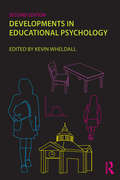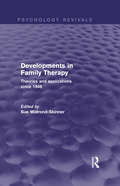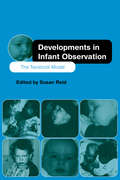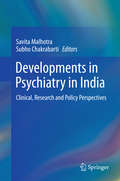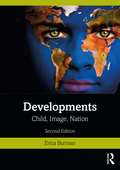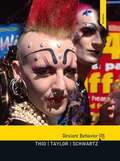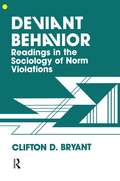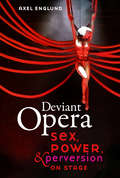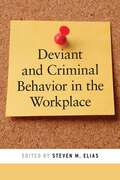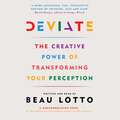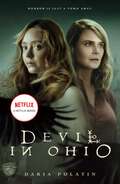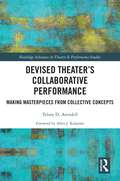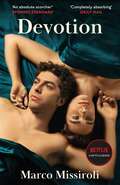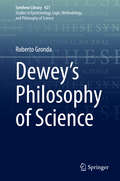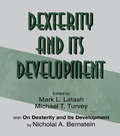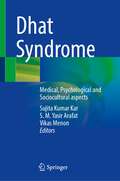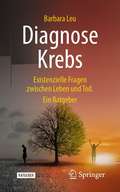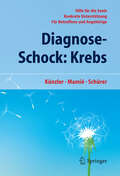- Table View
- List View
Developments in Educational Psychology: How Far Have We Come In 25 Years?
by Kevin WheldallReview comment on the first edition "Wheldall asks himself and his readers what has transpired within the field of educational psychology … and what its relevance actually is for teaching, learning and education. As such it is a ‘must read’ for all educational psychologists, students of educational psychology, teachers and teacher trainers." Professor Paul Kirschner, Open Universiteit, British Journal of Educational Technology What is the relevance of educational psychology in the twenty first century? In this collection of essays, leading educational psychologists reflect on the seminal developments which have been made in the field over the past twenty five years or so and assess how far we have progressed. Given a broad and personal remit to address a range of issues, the contributors review and critique a variety of topics, including: intelligence; communication; family environments; individual differences; reading; peer learning; classroom behaviour; and higher education. Providing provocative and challenging insights into the state of contemporary educational psychology, the contributors acknowledge throughout the successes and progression in the field, but with a critical edge and a challenge being thrown down to psychologists of education to make study more seriously informed and as a consequence, reformed. Now in its second edition this compelling text for students and researchers is thoroughly updated and includes four new chapters.
Developments in Family Therapy: Theories and Applications Since 1948 (Psychology Revivals)
by Sue Walrond-SkinnerOriginally published in 1981, this volume presents papers by the leading British theorists and practitioners in family therapy from its beginnings up to the 1980s. It collected together for the first time a number of important previously published articles which had relevance and interest for family therapists of the day, and includes other chapters specially written for this book which reflected the most recent thinking on the topics covered at the time. The book is divided into three parts. The first, which includes papers by John Bowlby, R.D. Laing and A.C.R. Skynner, deals with the theory behind family therapy. In the second part we see the application of family therapy to specific clinical situations such as adolescent psychiatry, illness, death and mourning in the family, and marital therapy. The third part of the book covers various differential approaches within family therapy, including psychoanalysis; the experiential approach and family construct psychology. The papers in all three parts weld together ideas from the behavioural and the psychodynamic spheres of interest. Addressed as they are to theoretical issues and clinical applications, they linked together the past and future of family therapy at that time.
Developments in Infant Observation: The Tavistock Model
by Susan ReidInfant observation carried out within the family is a compelling approach to the study of early human development, vividly revealing the impact of intergenerational patterns of child-rearing and the complex relationship between nature and nurture. It provides unique insights into the early origins of emotional disturbance and suggests ways in which healthy development can be promoted by both professional and parent, often resulting in changes to clinical practice. Developments in Infant Observation: The Tavistock Model is a collection of twelve key papers from international contributors. It offers an overview of current practice, explores the new concepts that have arisen from direct observation, and shows how the findings from observation are being applied in the research setting. An essential text for child psychotherapists in training and practice, this is a book that brings alive the academic theories of child development through thought-provoking and stimulating case-studies which will be of interest to any professional working with children.
Developments in Object Relations: Controversies, Conflicts, and Common Ground
by Lavinia GomezDevelopments in Object Relations provides a highly accessible account of how British Object Relations developed in the second half of the twentieth century, focusing on the generation who took up where Klein and Winnicott left off. Complementing and building on its predecessor, An Introduction to Object Relations, it gives an overview of the development of Object Relations with special reference to the Independent and Kleinian traditions. An introductory chapter defines the key features of Object Relations. The emergence of Object Relations is is then described theoretically from some of Freud’s papers and clinically from the controversial work of Sandor Ferenczi. Similarities and divergences between Kleinian and Independent approaches are considered in detail through the close examination of the work of a key practitioner from each approach, and other significant contributions. Gomez brings clarity to a complex field, discussing what is powerful and problematic about the two main strands in British psychoanalysis. Kleinian and Independent approaches are consistently compared and contrasted, so that readers can develop a clear idea of each. Rather than preferring one to the other, they are presented as different approaches to what is fundamental in psychoanalysis. Chapters on Bion and Masud Khan bring the work of each tradition to life in a fascinating and informative way. Gomez concludes by summarising the claim of psychoanalysis to offer a new way of understanding human reality, particularly useful for readers interested in her second book, The Freud Wars. Developments in Object Relations will be of great help to psychoanalysts and psychotherapists who work psychoanalytically, particularly those in the process of training, those who have recently qualified and those who are rethinking their position on the different, strongly-held views they encounter. This book is particularly timely when psychoanalytic approaches are under attack from treatments claiming to offer quicker and easier solutions.
Developments in Psychiatry in India
by Savita Malhotra Subho ChakrabartiThe volume evaluates major developments in psychiatry in India from the 1950s, and highlights the areas where Indian psychiatry has contributed to the development of the subject worldwide. The chapters review international as well as Indian developments in psychiatry and its sub-specialities. A wide range of clinical, research and policy-related topics have been covered in the volume, which begins with an overview of the history of psychiatry in India, moving on to developments in various sub-specialities of psychiatry in the last 60 years or so. It then specifically discusses developments in psychology and psychodynamics, general adult and child psychiatry, substance use psychiatry, community psychiatry, liaison psychiatry, and other psychiatric sub-specialities. Developments in treatment, the status of training and service in psychiatry and legal issues related to the practice of psychiatry in India are also included. The contributors to this volume are nationally and internationally recognized experts in different areas of psychiatry. Most of them have had some association, or are currently associated, with the Department of Psychiatry at the Post Graduate Institute of Medical Education and Research, Chandigarh, India.
Developments in Psychoanalysis
by Susan Isaacs Joan Riviere Melanie Klein Paula HeimannPsychoanalysis is a science evidently fore-ordained to growth and expansion, and among those who have extended the scope of both theory and practice Melanie Klein holds a unique place. This book is a survey of the developments in psychoanalytical knowledge resulting from her work. Her main discoveries relate to the very early phases of mental life. She recognized that the world of unconscious feeling and impulse (which we call 'phantasy') is the effective source of all human actions and reactions, modified though they are when translated into actual external behaviour or conscious thought. Although Freud first enunciated this truth, which originates in his fundamental discovery of the unconscious mind of man, he left many problems still unsolved. These have been brought nearer to a solution through Melanie Klein's consistent awareness of the significance of unconscious phantasy. Not only students of psychoanalysis and workers in related medical fields but also practising child-psychologists and the informed lay public will find this book of absorbing interest.
Developments: Child, Image, Nation
by Erica BurmanHow does developmental psychology connect with the developing world? What do cultural representations tell us about the contemporary politics of childhood? What is the political economy of childhood? This companion volume to Burman's Deconstructing Developmental Psychology helps us to explain why questions around children and childhood - their safety, their sexuality, their interests and abilities, their violence - have so preoccupied the late twentieth and twenty-first centuries. In this increasingly post-industrial, post-colonial and multicultural world, this book identifies analytical and practical strategies for improving how we think about and work with children. Drawing in particular on feminist and postdevelopment literatures, the book illustrates how and why reconceptualising our notions of individual and human development, including those informing models of children's rights and interests, will foster more just and equitable forms of professional practice with children and their families. The book brings together completely new, previously unpublished material alongside revised and updated papers to present a cutting-edge and integrated perspective to the field. Burman offers a key contribution to a set of urgent debates engaging theory and method, policy and practice across all the disciplines that work with, or lay claim to, children's interests. Developments presents a coherent and persuasive set of arguments about childhood, culture and professional practice so that the sustained focus across a range of disciplinary arenas (psychology, education, cultural studies, child rights, gender studies, development policy and practice, social policy) strengthens the overall argument of each chapter. It will be invaluable to teachers and students in psychology, childhood studies and education as well as researchers in gender studies. It will also be a must-read for professionals working with children and adolescents.
Developments: Child, Image, Nation
by Erica BurmanHow does developmental psychology connect with (what used to be called) the developing world? What do cultural representations indicate about the contemporary politics of childhood? How is concern about child sexual exploitation linked to wider securitization anxieties? In other words: what is the political economy of childhood, and how is this affectively organized? This new edition of Developments: Child, Image, Nation, fully updated, is a key conceptual intervention and resource, reflecting further on the contexts and frameworks that tie children to national and international agendas. A companion volume to Burman’s Deconstructing Developmental Psychology (third edition, 2017) this volume helps explain why questions around children and childhood, including their safety, welfare, their interests, abilities, sexualities and their violence, have so preoccupied the late twentieth and twenty-first centuries, showing how the frames for these concerns have extended beyond their Euro-US contexts of origination. In this completely revised edition, Burman explores changing debates and contexts, offering resources for interpreting continuities and shifts in the complex terrain connecting children and development. Through reflection on an increasingly globalised, marketised world, that prolongs previous colonial and gendered dynamics in new and even more insidious ways, Developments analyses the conceptual paradigms shaping how we think about and work with children, and recommends strategies for changing them. Drawing in particular on feminist and post-development literatures, as well as original and detailed engagement with social theory, it illustrates how and why reconceptualising notions of individual and human development, including those informing models of children’s rights and interests, is needed to foster more just and equitable forms of professional practice with children and their families. Burman offers an important contribution to a set of urgent debates engaging theory and method, policy and practice across all the disciplines that work with, or lay claim to, children’s interests. A persuasive set of arguments about childhood, culture and professional practice, Developments is an invaluable resource to teachers and students in psychology, childhood studies, and education as well as researchers in gender studies.
Deviant Behavior
by Alex D. Thio Jim D. Taylor Martin D. SchwartzDeviant Behavior challenges students' own biases and preconceptions. This best-selling text offers comprehensive coverage of all aspects of deviance and is noted for its blend of style and substance. Deviant Behavior covers a wide spectrum of theories of deviance, and analyzes numerous specific deviant behaviors. The author uses an abundance of research data, including many that debunk our common assumptions about deviant behavior. Students are exposed to the full range of theories and data about deviance, and are challenged to think about and evaluate their own biases and preconceptions. Learning Goals Upon completing this book, readers will be able to: Analyze numerous types of deviant behavior. Challenge their own biases and preconceptions on deviant behavior. Make connections between behavioral theories and concrete deviances. Develop new ways of seeing and understanding chapter material through critical thinking questions.
Deviant Behaviour: Readings In The Sociology Of Norm Violations (Routledge International Handbooks Ser.)
by Clifton D. BryantFirst published in 1990. Routledge is an imprint of Taylor & Francis, an informa company.
Deviant Love (Penguin Great Loves)
by Sigmund FreudSigmund Freud, the founder of modern psychoanalysis, remade our view of the human mind by exploring the unconscious forces that drive us. This collection of his groundbreaking writings on the psychology of love examines the nature of desire, transgression, fantasy and erotic taboo. United by the theme of love, the writings in the Great Loves series span over two thousand years and vastly different worlds. Readers will be transported to different places and introduced to love’s endlessly fascinating possibilities and varied forms: romantic love, platonic love, erotic love, gay love, virginal love, adulterous love, parental love, filial love, nostalgic love, unrequited love, illicit love, not to mention lost love, twisted and obsessional love…
Deviant Opera: Sex, Power, and Perversion on Stage
by Axel EnglundImagine Armida, Handel’s Saracen sorceress, performing her breakneck coloraturas in a black figure-hugging rubber dress, beating her insubordinate furies into submission with a cane, suspending a captive Rinaldo in chains from the ceiling of her dungeon. Mozart’s peasant girl Zerlina, meanwhile, is tying up and blindfolding her fiancé to seduce him out of his jealousy of Don Giovanni. And how about Wagner’s wizard, Klingsor, ensnaring his choir of flower maidens in elaborate Japanese rope bondage? Opera, it would appear, has developed a taste for sadomasochism. For decades now, radical stage directors have repeatedly dressed canonical operas—from Handel and Mozart to Wagner and Puccini, and beyond—in whips, chains, leather, and other regalia of SM and fetishism. Deviant Opera seeks to understand this phenomenon, approaching the contemporary visual code of perversion as a lens through which opera focuses and scrutinizes its own configurations of sex, gender, power, and violence. The emerging image is that of an art form that habitually plays with an eroticization of cruelty and humiliation, inviting its devotees to take sensual pleasure in the suffering of others. Ultimately, Deviant Opera argues that this species of opera fantasizes about breaking the boundaries of its own role-playing, and pushing its erotic power exchanges from the enacted to the actual.
Deviant and Criminal Behavior in the Workplace (Psychology and Crime #5)
by Steven M. EliasWorkplace crimes are never far from the news. From major scandals like Enron to violent crimes committed by co-workers to petty theft of office supplies, deviant and criminal behavior is common in the workplace. Psychological factors are almost always involved when an employee engages in such behavior. Deviant and Criminal Behavior in the Workplace offers insights at the level of the individual employee and also sheds light on the role organizations themselves may play in fostering such criminal behavior. The volume considers psychological factors involved in theft and fraud, workplace violence, employee discrimination, and sexual harassment. It also analyses a number of variables which can influence such behavior including employee personality, employee emotional processes, experience of occupational stress, organizational culture, organizational injustice, and human resource management practices. The book will be of core interest to those interested in the psychology and sociology of work, organizational behavior, and human resource management.
Deviate: The Science of Seeing Differently
by Beau LottoPerception is the foundation of human experience, but few of us understand how our own perception works. By revealing the startling truths about the brain and perception, Beau Lotto shows that the next big innovation is not a new technology: it is a new way of seeing.In his first major book, Beau Lotto draws on over a decade of pioneering research to show how our brains play tricks on us. With an innovative combination of case studies and optical and perception illusion exercises, DEVIATE will revolutionise the way you see the world. With this new understanding of how the brain works and its perceptive trickery, we can apply these insights to every aspect of life and work. DEVIATE is not just an engaging look into the neuroscience of thought, behaviour and creativity: it is a call to action, enlisting readers in their own journey of self-discovery.(p) 2017 Hachette Audio
Devil in Ohio
by Daria Polatin"Devil in Ohio kept me up until 3 a.m. with the lights on–in a good way. It’s a haunting thriller for readers who like fear, humor, and heart in one package."—Meredith Goldstein, advice columnist and feature reporter for The Boston Globe, author of upcoming YA novel Chemistry Lessons."Gripping, urgent and addictive, Devil in Ohio balances the dark exploration of cults with a compelling and often humorous take on teen social dynamics. This is the debut you won’t want to miss."—Aditi Khorana, author of critically acclaimed The Library of Fates and Mirror in the SkyWhen fifteen-year-old Jules Mathis comes home from school to find a strange girl sitting in her kitchen, her psychiatrist mother reveals that Mae is one of her patients at the hospital and will be staying with their family for a few days. But soon Mae is wearing Jules’s clothes, sleeping in her bedroom, edging her out of her position on the school paper, and flirting with Jules’s crush. And Mae has no intention of leaving.Then things get weird.Jules walks in on a half-dressed Mae, startled to see: a pentagram carved into Mae’s back. Jules pieces together clues and discovers that Mae is a survivor of the strange cult that’s embedded in a nearby town. And the cult will stop at nothing to get Mae back.
Devil in the Details: Scenes from an Obsessive Girlhood
by Jennifer TraigThe author gives a humorous account of her battles with obsessive-compulsive disorder while growing up.
Devised Theater’s Collaborative Performance: Making Masterpieces from Collective Concepts (Routledge Advances in Theatre & Performance Studies)
by Telory D ArendellThis book provides a fascinating and concise history of devised theatre practice. As both a founding member of Philadelphia’s Pig Iron Theater Company and a Professor, Telory Arendell begins this journey with a brief history of Joan Littlewood’s Theatre Workshop and Living Newspapers through Brecht’s Berliner Ensemble and Joe Chaikin’s Open Theatre to the racially inflected commentary of Luis Valdez’s Teatro Campesino and Ariane Mnouchkine’s collaboration with Théâtre de Soleil. This book explores the impact of devised theatre on social practice and analyzes Goat Island’s use of Pina Bausch’s gestural movement, Augusto Boal’s Theatre of the Oppressed in Giving Voice, Anna Deavere Smith’s devised envelope for Verbatim Theatre, The Tectonic Theatre Project’s moment work, Teya Sepinuck’s Theatre of Witness, Pig Iron’s use of Lecoq mime to build complex physical theatre scripts, and The Riot Group’s musical arrangement of collaborative devised text. Included are a foreword by Allen J. Kuharski and three devised plays by Theatre of Witness, Pig Iron, and The Riot Group. Replete with interviews from the initial Pig Iron collaborators on subjects of writing, directing, choreographing, teaching, and developing a pedagogical platform that supports devised theatre.
Devotion: Soon a Netflix limited series
by Marco MissiroliNOW A NETFLIX LIMITED SERIES, COMING VALENTINE'S DAY 2022 'An absolute scorcher' Evening Standard'The book about infidelity that has shaken up Italy'The Times'Intimate and ultimately moving... completely absorbing'Daily Mail'A gripping novel exploring the tensions in an apparently idyllic marriage' Financial Times 'A must-read'Sydney Morning Herald'Devotion thrilled me, made me think and moved me deeply... Irresistible'Jonathan Safran FoerCarlo, a part-time professor of creative writing, and Margherita, an architect-turned-real estate-agent: a happily married couple in their mid-thirties, perfectly attuned to each other's restlessness. They are in love, but they also harbour desires that stray beyond the confines of their bedroom: Carlo longs for the quiet beauty of one of his students, Sofia; Margherita fantasises about the strong hands of her physiotherapist, Andrea.But it is love, with its unassuming power, which ultimately pulls them from the brink, aided by Margherita's mother Anna, the couple's anchor and lighthouse - a wise, proud seamstress hiding her own disappointments.But after eight years of repressed desires and the birth of a son, when the past resurfaces in the form of books sent anonymously, will love be enough to save them? A no. 1 international bestsellerWinner of the Premio Strega GiovaniShortlisted for the Premio Strega'Powerful, delicate, exquisite' Claudio Magris 'Masterful... The ending is just as good as that of Joyce's The Dead' Corriere della Sera'You'll feel like taking refuge in this book and never leaving its confines' La Stampa'With all-encompassing writing, Marco Missiroli opens the rooms of his characters and the streets of Milan, the thoughts and the concealed desires, makes dialogue and silences reverberate with the spontaneity of great narrators' Il Foglio
Dewey's Philosophy of Science (Synthese Library #421)
by Roberto GrondaThis monograph presents a unitary account of Dewey’s philosophy of science and demonstrates the relevance for contemporary debates. The book is written from a theoretical angle and explains Dewey's via on Experience, Language, Inquiry, Construction and Realism. Via taking this route the book addresses key philosophical problems - such as the nature of language, the idea of experience, the notion of logical constructivism, the criticism of representationalism and the nature of scientific practices.John Dewey (1859-1952) is one of the most representative philosophers of the United States. He is well known for his work in education, psychology and social reform and one of the primary figures associated with the philosophy of pragmatism. His Philosophy of Science underwent a period of almost total unpopularity and neglect. In recent times, however, as a consequence of the strong pragmatist renaissance we are now witnessing, Dewey’s philosophy of science has attracted new attention. This book presents for the first time a comprehensive overview of Dewey's philosophy of science and will be of interest to scholars working in nineteenth and twentieth century philosophy of science and on the relationship between Pragmatism and Logical Empiricism.
Dexterity and Its Development (Resources for Ecological Psychology Series)
by Nicholai A. BernsteinThis is a very unusual book. It brings to the English speaking reader a masterpiece written some 50 years ago by one of the greatest minds of the 20th century--Nicholai Aleksandrovich Bernstein--considered the founder of many contemporary fields of science such as biomechanics, motor control, and physiology of activity. Divided into two parts, this volume's first section is a translation of the Russian book On Dexterity and Its Development. It presents, in a very reader-friendly style, Bernstein's major ideas related to the development and control of voluntary movements in general, and to the notion of dexterity, in particular. Although very few scientific works remain interesting to the reader 50 years after they were written, this volume--now available for the first time in English--is a rare exception to this rule. His ideas are certainly not obsolete. Actually, we are just starting to grasp the depth and breadth of his thinking, especially his analysis of the complex notion of dexterity. The second section provides both a historical and a contemporary perspective on Bernstein's ideas. The original work was directed at a wide audience ranging from specialists in biomechanics and motor behavior, to coaches, neurologists, physical therapists, athletes, and even inquisitive college and high school students. The chapters contributed by contemporary scientists mirror Bernstein's style and present new findings in the areas of biomechanics, motor control, and motor development in a way that would be both understandable to non-specialists in these areas, and informative for professionals working in different areas related to human movement. All those interested in the origins and mechanisms of the production of voluntary movements, irrespective of their educational and professional background, will find this book valuable. In addition, the unique history and composition of this text will make it helpful and attractive to historians and philosophers of science.
Dhan-Sampatti Ka Manovigyan: धन-संपत्ति का मनोविज्ञान
by Morgan Houselधन का प्रबंधन, निवेश और उद्यम संबंधी निर्णय लेना ऐसे विषय माने जाते हैं जिनमें आमतौर पर काफी गणितीय हिसाब किताब होता है, जहाँ डेटा और फ़ॉर्मूले हमें बताते हैं कि आखिर क्या करना है। लेकिन वास्तविक संसार में, लोग वित्तीय निर्णय स्प्रेडशीट पर नहीं लेते। वे खाने की मेज पर या किसी सभाकक्ष में उन्हें बनाते हैं, जहाँ व्यक्तिगत इतिहास, संसार के प्रति आपका अद्वितीय दृष्टिकोण, अहंकार, अभिमान, मार्केटिंग, और विचित्र प्रेरक साथ में उलझे होते हैं। धन-संपत्ति के मनोविज्ञान में लेखक ने 19 लघु कहानियाँ प्रस्तुत की हैं, जो धन के बारे में लोगों की विचित्र सोच का समन्वेषण करती है, और साथ ही आपको सिखाती हैं कि आप किस प्रकार जीवन के इस सवाधिक महत्वपूर्ण पहलू को बेहतर रूप से समझ सकते हैं।
Dhat Syndrome: Medical, Psychological and Sociocultural aspects
by S. M. Yasir Arafat Sujita Kumar Kar Vikas MenonDhat Syndrome is known as a culture-bound syndrome in South Asia. People with Dhat Syndrome often present with anxiety and distress related to semen loss. Multiple somatic and sexual symptoms often accompany this. The symptoms of Dhat Syndrome closely resemble other neurotic and stress-related disorders. Myths related to sexuality are often the core phenomenon in dhat syndrome, which is responsible for the generation of psychopathology—addressing the myth's preliminary results in resolving psychopathology. However, many patients require pharmacological and psychological management. Due to strong cultural beliefs and associated myths, patients with Dhat Syndrome often reach out to traditional healers before getting the proper psychiatric consultation, further consolidating their myths and poor attitude toward treatment. However, Dhat Syndrome resembles a male entity; a similar entity is reported in females, where females attribute their non-pathological vaginal discharge to psychological distress. The pattern of symptoms has a significant resemblance with Dhat Syndrome in males. There is no standard book that exclusively discusses various aspects of Dhat Syndrome. This book examines the evolution of Dhat Syndrome to the current understanding of the disease and its management. Hence, this book will be unique and helpful for this disorder.
Diabetes and Couples: Protective and Risk Factors
by Rozzana Sánchez-AragónThis book shows how psychological aspects of individuals and of couple relationships can work as both protective or risk factors to the health of diabetes patients and their partners. Departing from a social psychologic perspective, it analyzes how individual attributes and personal relationships influence health, focusing on the impacts that diabetes as a chronic-degenerative disease has on the psychological state of the patient and on their most immediate social context. The volume is divided in three parts: the first focuses on the patient, the second on the partner and the third on the couple relationship. The first part examines how attachment styles, optimism, resilience, self-efficacy in emotional regulation, loneliness and rumination impact the stress experienced by the diabetic patient. The second part analyzes how the partner’s altruism, affectivity, jealousy, criticism or indifference affects the physical health of the diabetic patient. Finally, the third part explores the relationship between negative emotions and the couple’s motives of conflict, as well as the effects of the communication styles used, emotional warmth and empathy in the satisfaction with the relationship in couples where one of the members is a diabetes patient. Diabetes and Couple Relationship: Protective and Risk Factors will be a valuable resource for researchers, students and professionals in the fields of health and clinical psychology, social psychology and public health interested in better understanding how personal characteristics and relationships can affect the physical and psychological health of chronic disease patients, as well as their well-being and quality of life.
Diagnose Krebs: Existenzielle Fragen zwischen Leben und Tod. Ein Ratgeber
by Barbara LeuDie Diagnose Krebs ist für die meisten Menschen ein Schlag mitten ins Gesicht. Nichts mehr ist, wie es einmal war: Das Gedankenkarussell beginnt zu drehen, den Betroffenen stellen sich unzählige Fragen – nach dem Leben und nach dem möglichen Tod.Krebs-Ratgeber gibt es viele und sehr unterschiedliche. Dieser Ratgeber soll nicht einer mehr sein. Er hat wohl die Krebserkrankung und ihre Auswirkungen auf Betroffene und ihre Angehörigen im Zentrum, die Perspektive liegt jedoch immer auf den daraus resultierenden existenziellen Thematiken und Fragestellungen:Warum gerade ich?Wie kann ich das große Leid verkraften?Wie geht mein Leben nach der Krebsdiagnose weiter?Wie kann ich mit der Angst vor dem Tod umgehen?Fall ich anderen zur Last?Trage ich am Ende noch selbst Schuld?Was kann ich als Angehörige*r tun?Diese und weitere existenzielle Fragen und Themen nimmt der vorliegende Ratgeber mit konkreten Fallbeispielen und Hintergrundwissen aus der psychoonkologischen Praxis der Autorin auf und gibt darüber hinaus Anregungen für den Umgang mit solch schweren Erkrankungen. Praktische Tipps und zahlreiche Hilfsangebote zu den einzelnen Themen runden diesen Ratgeber ab.
Diagnose-Schock: Krebs
by Alfred Künzler Andrea Fischer Schulthess Jörg Kyburz Stefan Mamié Susanne Fazekas-Stenz Carmen Schürer Sabine LenzDiagnose-Schock: Krebs Diagnose Krebs: Über 500.000 Menschen in Deutschland, Österreich und der Schweiz erhalten jährlich die Diagnose Krebs. Die medizinischen Fragestellungen haben dann Priorität, oft wird aber die psychologische Betreuung der Patienten auch im Verlauf der Behandlung zu wenig berücksichtigt. Studien zeigen zudem, dass die Partner Krebsbetroffener häufig noch stärker belastet sind als die Patienten. Hilfe für die Seele Dieses Buch bietet praktische Unterstützung für beide Seiten: Patienten und ihre Partner, Freunde, Begleiter. Ziele des Buches: - Sorgen und Hilflosigkeit vermindern - Ihre Lebensqualität verbessern - Selbsthilfe und Selbststeuerung anregen - Sie unterstützen, mit der Erkrankung umzugehen und für sich selbst zu sorgen - Sie unterstützen, Ihren eigenen Weg zu finden - Ihnen in schwierigen Situationen Möglichkeiten aufzeigen - Sie unterstützen, wichtige Dinge nicht zu verpassen. Als klinisch tätige Psychoonkologen zeigen die Autoren vielfach erprobte Hilfestellungen auf. Leserinnen und Leser erhalten kurze, gut lesbare Erklärungen und Anleitungen, die die Ressource Menschlichkeit nutzen. Geschrieben ist das Buch für Betroffene und Angehörige sowie für medizinische und psychosoziale Fachleute in Klinik, Praxis und Reha, die mit Krebsbetroffenen arbeiten. Der praktische Ratgeber für Betroffene und Angehörige: In der Krise lesbar und bezogen auf den ganzen Menschen
